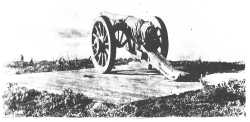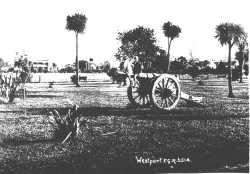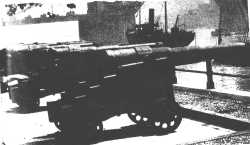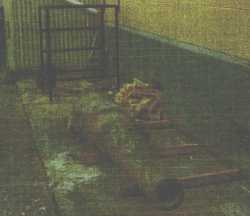|
| |
Armstrong RBL 40-pr | |

Fig.1: Armstrong RBL 40-pr (calibre 4.75 inches) at North Battery, North Head, Devonport from a photo taken in 1880. Click image to enlarge.
| |
|
Armstrong 40-pr guns were employed on two important occasions during the New Zealand Wars of the 1860s. The first involved two on travelling carriages as depicted in Fig. 1 at the Whangamarino Redoubt during the period August-November 1863. They were employed in shelling the Maori positions at Meremere. Being heavy and difficult to move over rough country they did not see extensive service. Having been acquired by the New Zealand Government they were moved to North Head, Devonport, c1870 where they were employed in the coast defence role. Although an official report on the defence of Auckland in 1871 recommended the guns be mounted on garrison carriages (which could have been made in New Zealand), and emplaced behind protective parapets, those responsible did nothing. After fortification of North Head began in 1885 the two 40-prs were sent to Fort Takapuna where they were relegated to a practice role. One was damaged in an accident and although a recommendation was made that it be sent to England for repair no record of what actually happened to it can be found. As Armstrong guns were by then obsolete possibly it was quietly scrapped. The other gun was c1894 sent to Westport for coast defence, and served in that role until c1904 when the local Garrison Artillery volunteers converted to field. Fig. 2 is a copy of a photograph taken at Westport during the 1920s by which time the gun had become a museum piece. | |
|
Fig. 2: RBL 40-pr on travelling carriage from a photo taken about 1922. Members of the 'detachment' are unfortunately not known; if they were they would be 'on the mat' for not showing due deference to one of His Majesty's pieces of ordnance! Click image to enlarge it. | |
|
Two RBL 40-prs on four-truck naval carriages were employed to bombard the Gate Pa (Pukehinahina) at Tauranga on 29 April 1864. These guns were brought ashore from HMS Esk and manhandled into position by the troops. After the battle they were returned to the ship. See Fig. 3. | |
|
Fig. 3: RBL 40-pr on garrison four-truck carriages from a photo taken at the Tower of London. They have since been scrapped. The two which bombarded Gate Pa in 1864 would have been mounted on similar carriages except the wheels would have been made of wood. The Navy never used iron wheels because they would have damaged the decks. Click image to enlarge it. | |
|
During the Great Depression (1929-34) and the years immediately preceding World War 2 soldiers - and anything connected with soldiers - became extremely unpopular with a certain section of the populace noted for short memories and for politics more than tinged with red. As the writer vividly recalls, soldiers, even Territorials, were openly referred to as "Gordon Coates' bastards" (from Major Gordon Coates MC and Bar who fought for them in World War 1), "bludgers on the economy", "uneconomic units" etc etc, and demanded that money spent on defence be paid to the unemployed. At the same time they pressured local bodies who displayed old guns in parks to bury them . These people believed, so they said, that if trophies of war were put out of sight there would be no more wars! Thus our truly historic 40-pr was buried, and when "resurrected" after the opening of the Army Memorial Museum the piece as shown in Fig. 4 was all that remained. | |
|
Fig. 4: All that is now left of the RBL 40-pr depicted in Figs. 1 and 2. The breech screw is included but not the vent piece. Click image to enlarge it. | |
|
As there are no trunnion bearings nor other parts forming the traversing gear - which were bronze and therefore probably 'hocked' as scrap by the buriers - restoration as a field gun would be very difficult. Nevertheless display on a carriage similar to that shown in Fig. 3 would not be inappropriate provided it was fully and correctly captioned. CONSTRUCTION: See Fig. 5. The gun is of 'built-up' construction, consisting of an 'A' tube over which other tubes have been fitted by shrinkage. All parts are of wrought iron except the breech screw and vent piece which are of steel. | |
|
Fig 5: RBL 40 pr showing construction of piece. Click image to enlarge it. | |
|
Construction of the carriage is shown in Fig. 8 (Large file: 78kB). Trail and saddle were of oak. In the wheels oak was used for spokes, ash for felloes, and elm for naves. In tool and spare parts boxes deal (Baltic pine) was used for the sides and elm for the ends. Metal fittings were of wrought iron with the exception of the trunnion/traversing bearings, handwheels and bearings which were of bronze. | |
|
Fig. 6: RBL 40-pr on 6-foot parapet siege carriage from a drawing made in 1880.
Click image to enlarge it. | |
|
The 40-pr was designated a 'siege' gun, i.e. designed for the siege of fortified works in the field. Today it would be designated 'medium'. Note that the gun has a 'side-closing' mechanism, i.e. the piece has been rotated through 90° in the trunnion ring to bring the vent piece horizontal. See Fig. 7 for details.
| |
|
Fig. 7: Modified breech for medium and heavy RBL guns. The vent piece has been converted to a horizontal sliding block. It no longer includes the vent; the gun has been radially vented as shown. The idea possibly came from Germany where all breeches featured a horizontal sliding block or 'wedge'.
Click image to enlarge it. | |
|
In 1880 a proposal was made to convert RBL 40-pr and 7-inch RBL guns into side-closing pieces. As well as making handling more convenient, the conversion saved much labour, as the vent piece no longer had to be completely removed for loading. Experimental guns were prepared, other systems of obturation tried, as well as projectiles with copper driving bands (invented by Vavasseur in 1874). The modified guns were said to have '... answered extremely well' but the expense involved, especially for new ammunition, ruled out further action. The Committee on Ordnance appointed to investigate the matter of breech-loading had already made up their minds to adopt the de Bange system of 1877, named after Captain de Bange of the French Army who invented it in 1872. SIGHTS: A simple tangent sight consisting of a bar graduated in yards inserted in a socket on the breech was fitted. AMMUNITION: The propellant charge was one eighth the weight of the standard projectile. In the 40-pr 5 lbs (2.27 kg). Projectiles included common shell, segment and shrapnel. Shot were used for practice. WL Ruffell
The Armstrong Gun | Guns at Waiouru | Guns around New Zealand | More equipments | Home | |





